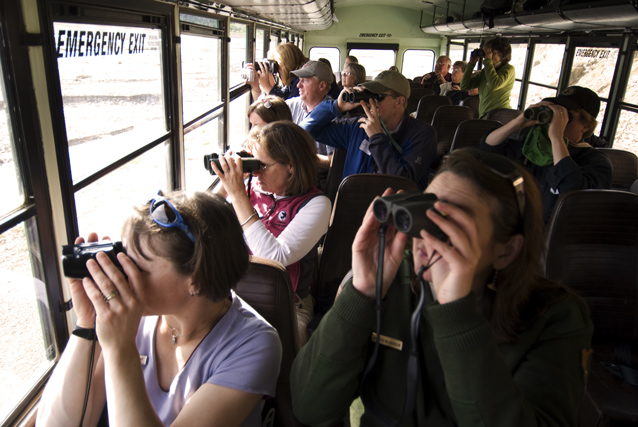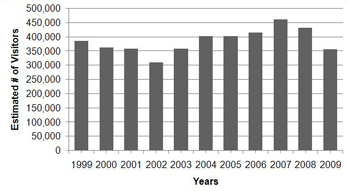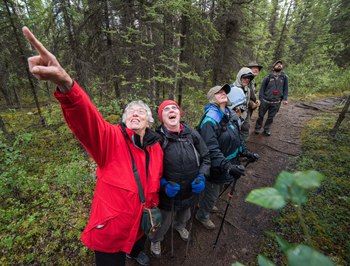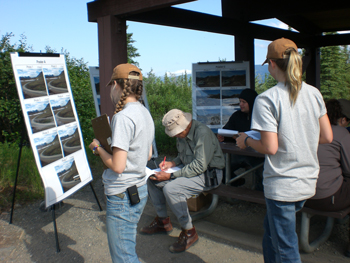
NPS Photo / Kent Miller
How many people visit Denali National Park and Preserve each year? Where are park visitors from? What is their median age? Where do visitors spend their time? What kind of experiences do they have? How can park managers protect park resources while providing quality experiences for visitors? These are the kinds of questions that social scientists ask and answer.

Counting visitors to Denali
Most visitors arrive at the park to enjoy Denali’s spectacular scenery, wildlife, and wilderness values. But where they arrive and where they go differ greatly. Some may arrive by train and take in the exhibits at the Denali Visitor Center as part of a package tour, road trippers may drive a private vehicle 15 miles along the paved part of the Denali Park Road, some visitors may get a ticket and jump on a bus for a cultural tour or a visit to Wonder Lake. Mountaineers may fly from Talkeetna to the Kahiltna Glacier before climbing Mt. McKinley. Others may fly and land on a glacier in the Alaska Range with a licensed tour operator. Some may arrive by train and backpack to remote backcountry locations seldom seen by other visitors.
Because there are large numbers of visitors to Denali (approximately 400,000 a year), and because visitors use many park access points and modes of travel, in order to get a reasonably accurate count of visitors, social scientists combine direct counts (e.g. number of passengers on a bus or vehicle counts from traffic counters), with predictive models and estimated information (e.g., using an estimate for the average number of people in a vehicle to derive visitors by private vehicle from traffic counters). Due to changing visitor use patterns, the formula used to predict vistation is being revised.

NPS Photo / Kent Miller
How and where visitors spend their time?
Park managers are interested in finding out not only how many people are visiting Denali (see graph on reverse), but also want to know what social scientists call visitor use characteristics, that is, where visitors go and the types of activities they participate in, as well as how people would describe or “rate” their park experiences. The National Park Service wants to improve existing conditions and facilities such that visitor experiences are of the highest quality without compromising the protection of park resources. Social scientists develop surveys to sample visitors, and rely on voluntary participation by visitors in answering surveys, in order to get more detailed information about trip characteristics (e.g. how long were you in the park today? What did you like best about your bus trip?) Don’t be surprised if you, as a visitor to Denali, are asked to complete a survey!
Benefits of studying visitor use characteristics
Among the many reasons to better understand visitor use characteristics is the ability to be able to track trends in types of use over time. If park managers can be alerted to changes in visitation (numbers, use characteristics, and behaviors of people who are in the park), often preventative action can be taken to avoid potential user conflict with, or damage to, sensitive biological, physical, cultural, or historical resources in the park.
Additionally, park managers can use information on visitation to determine if new facilities are needed in the future, and if so, what type and at what scale they are needed.
Because visiting a park is almost always associated with lodging, food, and other costs of recreation, economics is an area of social science that helps to inform managers and local businesses or chambersof- commerce as to what it is that visitors are most interested in paying for, how that demand is changing over time, and what role that spending plays in the larger regional economic picture.

NPS Photo / Kent Miller
Identifying Denali’s User Groups
Social science researchers are working to improve how visitors are counted and characterized. To better understand visitor use characteristics, scientists divide visitors into user groups based on differences. Some classifications include visitors divided by age categories; visitors from Alaska versus international travelers versus those from the Lower 48; visitors who enter the park via air (flightseeing by plane or helicopter) versus those who arrive by private vehicle or train; and visitors who ride buses on the park road and those who don’t.
Learning about off-season visitors
Denali’s researchers are working to better understand off-season visitation. Use of unobtrusive, automated trail counters can be extremely effective in getting counts of skiers or mushers who use trails or areas where entry is funneled through a clearlydesignated access point (e.g. the winter trailhead at Mile 3, see photo) or somewhat confined by natural features, such as a narrow valley or clearing of trees.
Assessing the Quality of Visitor Experiences
As mentioned above, social scientists also want to assess the quality of the experience that the visitor is having. In Denali, scientists have begun to do this by asking visitors to respond to a variety of types of surveys that reflect what it is that people are seeing, hearing, and generally experiencing while in the park. For example, previous studies have looked at how a backcountry hiker’s experience is affected by seeing garbage, other humans, and mechanized noise from airplane overflights.
Natural soundscapes are considered a park resource. As a result, park managers are attempting to address how overflights affect soundscapes and wilderness experiences. Research will continue to document the frequency and intensity of these sounds, while social science surveys are planned to help understand visitor sensitivity and preferences related to these sounds.
Another social study underway will survey hikers (day and overnight) to determine whether their backcountry experiences as reported in the survey are consistent with the management standards as outlined in the 2006 Backcountry Management Plan (amendment to Denali’s General Management Plan).
Part of the mission of the National Park Service is to provide high quality experiences for this and future generations. Therefore, Denali needs to monitor over time how well the park is doing at providing opportunities for the public to have high-quality and diverse experiences.
Last updated: April 21, 2016
